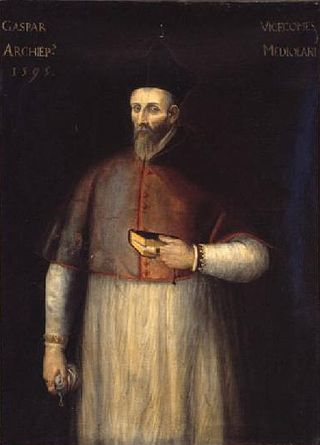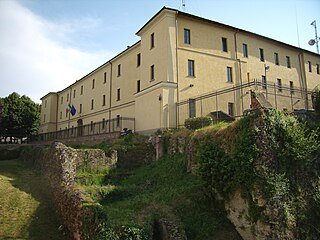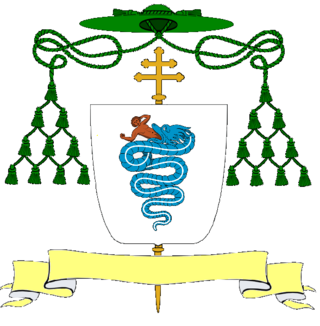
Galeazzo II Visconti was a member of the Visconti dynasty and a ruler of Milan, Italy. His most notable military campaigns were against Pope Gregory XI, around 1367. These battles fought between the papacy and the Visconti family ultimately ended in a peace treaty. Politically active, he expanded the power of his family, where the Visconti first became hereditary rulers of Milan starting in 1349. He is remembered in conjunction with his patronage of intellectuals and writers, from his sponsorship of Petrarch to the founding of the University of Pavia in 1361. Galeazzo II Visconti, and his brother Bernabò, are credited with the institution of the Quaresima Torture Protocol, a vicious means of torture.

The Visconti of Milan are a noble Italian family. They rose to power in Milan during the Middle Ages where they ruled from 1277 to 1447, initially as Lords then as Dukes, and several collateral branches still exist.

The Duchy of Milan was a state in Northern Italy, created in 1395 by Gian Galeazzo Visconti, then the lord of Milan, and a member of the important Visconti family, which had been ruling the city since 1277.

The Archdiocese of Milan is a Latin Church ecclesiastical territory or archdiocese of the Catholic Church in Italy which covers the areas of Milan, Monza, Lecco and Varese. It has long maintained its own Latin liturgical rite usage, the Ambrosian rite, which is still used in the greater part of the diocesan territory. Among its past archbishops, the better known are Ambrose, Charles Borromeo, Pope Pius XI and Pope Paul VI.

Bernabò or Barnabò Visconti was an Italian soldier and statesman who was Lord of Milan. Along with his brothers Matteo and Galeazzo II, he inherited the lordship of Milan from his uncle Giovanni. Later in 1355, he and Galeazzo II were rumoured to have murdered their brother Matteo since he endangered the regime. When Galeazzo II died, he shared Milan's lordship with his nephew Gian Galeazzo. Bernabò was a ruthless despot toward his subjects and did not hesitate to face emperors and popes, including Pope Urban V. The conflict with the Church caused him several excommunications. On 6 May 1385, his nephew Gian Galeazzo deposed him. Imprisoned in his castle, Trezzo sull'Adda, he died a few months later, presumably from poisoning.

Giovanni Visconti (1290–1354) was an Italian Roman Catholic cardinal, who was co-ruler in Milan and lord of other Italian cities. He also was a military leader who fought against Florence, and used force to capture and hold other cities.

Agnese Visconti also known as Agnes was a daughter of Bernabò Visconti and his wife Beatrice Regina della Scala. She was the consort of Mantua by her marriage to Francesco I Gonzaga.

Antonia Visconti was Countess of Württemberg.

BeatriceCane, mistakenly known in much of the historiography as Beatrice Lascaris di Tenda but actually a member of the Cane family, was an Italian noblewoman who married first the condottiero Facino Cane, Count of Biandrate and a cousin once removed, and then Filippo Maria Visconti, Duke of Milan, who later had her killed.

Gaspare Visconti was the Archbishop of Milan from 1584 to 1595.

Filippo Maria Visconti (1721–1801) was the Archbishop of Milan from 1784 to 1801.

Cassone della Torre, also called Mosca was an Italian medieval condottiero and feudal lord. A member of the Torriani family, he was Archbishop of Milan from 1308 to 1316 and patriarch of Aquileia from 1317 to 1318.

The Visconti Castle or Castello Visconteo of Cassano is a castle of medieval origin in Cassano d'Adda, Lombardy, Northern Italy. It received the current form in the 14th century, when Bernabò Visconti, lord of Milan, enlarged the existing fortification as part of a defensive system of the Visconti dominions on the Adda river. At the end of the 20th century, after a period of abandonment, it was restored and transformed into a hotel.

The Visconti Castle of Lodi is a historical building in Lodi, Lombardy, northern Italy. As it appears today, it is the result of transformations made on a Middle Age castle founded in the 12th century by Frederick Barbarossa. Its name derives from the Visconti family, lords and dukes of Milan, who in the 13th and 14th centuries took possession of and then rebuilt the original fortification.

The Arese are a prominent family of the Milanese nobility.

Giovanni III Visconti was the Italian Catholic Archbishop of Milan.
Arnulf I, known as Arnulf of Arzago, was the archbishop of Milan from 970 to 974.

The siege of Mirandola in 1355, was a military conflict involving Francesco II Pico, first lord of Mirandola, against Bernabò Visconti.

San Giovanni in Conca was a church in the center of Milan, northern Italy, dedicated to Saint John the Evangelist. It had a Paleochristian origin and went through a renovation in Romanesque style. In the 13th century, it became part of the private compound of the Visconti house and transformed into the private chapel of Bernabò Visconti and his wife Regina Della Scala, Lord and Lady of Milan. After their deaths, it housed their burial site. In the 19th and 20th centuries, it was downsized and finally demolished. Only the crypt and part of the apse have been preserved and are today visible in Piazza Missori. Fragments of the frescoes decorating the walls and the burial monuments of Bernabò and his wife have been preserved and transferred to the Sforza Castle Civic Museums.




















